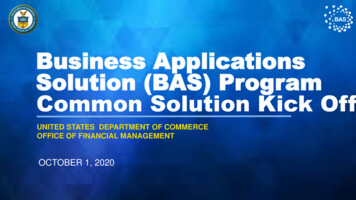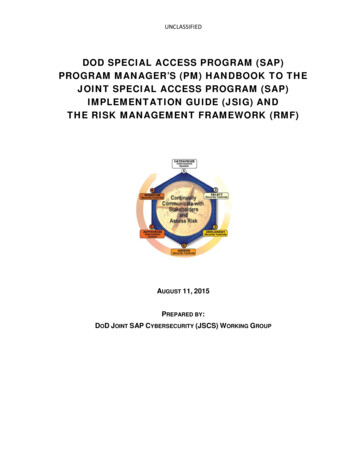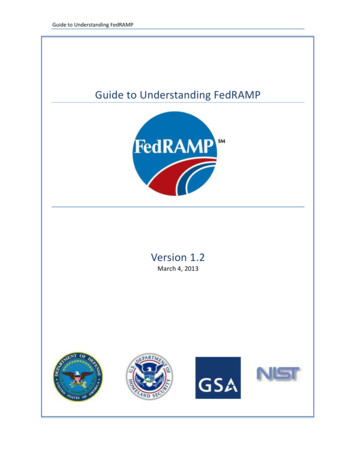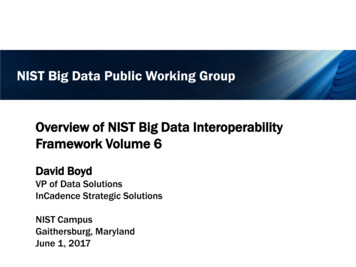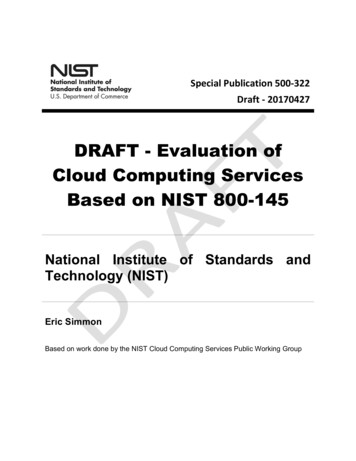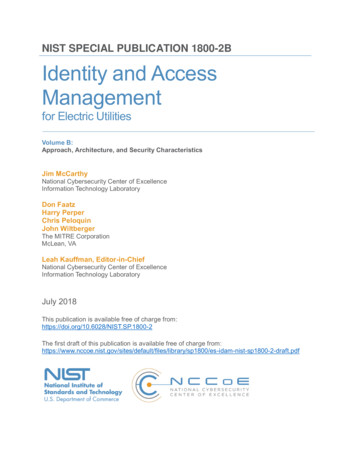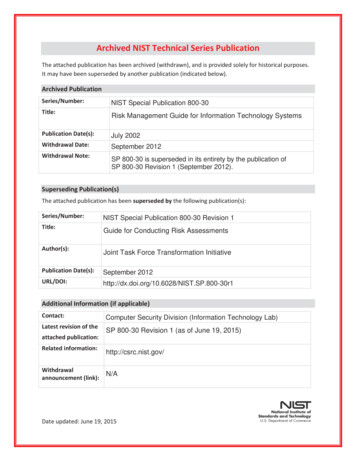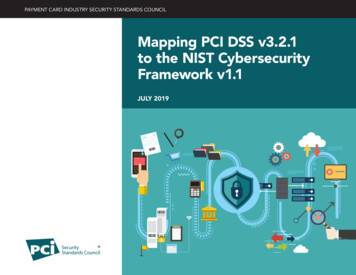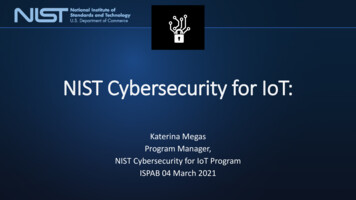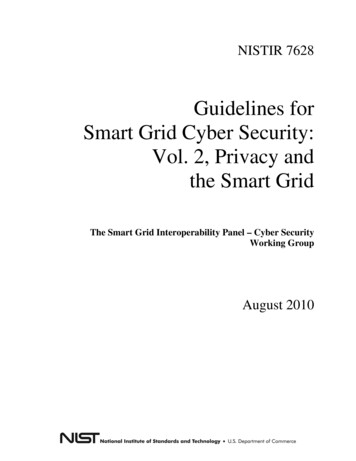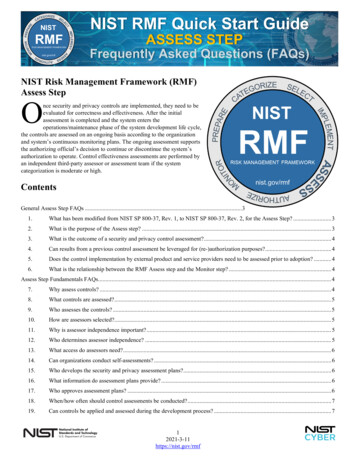
Transcription
NISTRMFRISK MANAGEMENT FRAMEWORKnist.gov/rmfNIST RMF Quick Start GuideASSESS STEPFrequently Asked Questions (FAQs)NIST Risk Management Framework (RMF)Assess StepOnce security and privacy controls are implemented, they need to beevaluated for correctness and effectiveness. After the initialassessment is completed and the system enters theoperations/maintenance phase of the system development life cycle,the controls are assessed on an ongoing basis according to the organizationand system’s continuous monitoring plans. The ongoing assessment supportsthe authorizing official’s decision to continue or discontinue the system’sauthorization to operate. Control effectiveness assessments are performed byan independent third-party assessor or assessment team if the systemcategorization is moderate or high.ContentsGeneral Assess Step FAQs . 31.What has been modified from NIST SP 800-37, Rev. 1, to NIST SP 800-37, Rev. 2, for the Assess Step? . 32.What is the purpose of the Assess step? . 33.What is the outcome of a security and privacy control assessment?. 44.Can results from a previous control assessment be leveraged for (re-)authorization purposes? . 45.Does the control implementation by external product and service providers need to be assessed prior to adoption? . 46.What is the relationship between the RMF Assess step and the Monitor step? . 4Assess Step Fundamentals FAQs . 47.Why assess controls? . 48.What controls are assessed? . 59.Who assesses the controls? . 510.How are assessors selected?. 511.Why is assessor independence important? . 512.Who determines assessor independence? . 513.What access do assessors need? . 614.Can organizations conduct self-assessments? . 615.Who develops the security and privacy assessment plans?. 616.What information do assessment plans provide? . 617.Who approves assessment plans? . 618.When/how often should control assessments be conducted? . 719.Can controls be applied and assessed during the development process? . 712021-3-11https://nist.gov/rmf
NISTRMFRISK MANAGEMENT FRAMEWORKnist.gov/rmfNIST RMF Quick Start GuideASSESS STEPFrequently Asked Questions (FAQs)20.Can the results of control assessments conducted during the system development life cycle be used?. 721.Can control assessment results be reused? . 722.During which phase of the system development life cycle should controls be assessed? . 723.What happens after the controls are assessed? . 824.Why are assessment reports important and who creates the reports? . 825.Can executive summaries be used to provide authorizing officials and other stakeholders control assessment information?What information should be included in the executive summary?. 826.What is a plan of action and milestones (POA&M)? . 827.Who prepares the plan of action and milestones? . 928.What information is used to develop a plan of action and milestone? . 929.Are plans of action and milestones part of the authorization package? . 930.Can the authorizing official designated representative accept the plan of action and milestones? . 931.What if security and privacy controls are provided by external entities? . 932.Can automation be used to conduct control assessments? . 933.Whose responsibility is it to respond to risks from assessment findings? . 934.Who determines remediation actions? . 1035.Who updates the security and privacy plans after a control assessment? . 1036.Why are control reassessments conducted? . 10Organizational Support for the Assess Step FAQs . 1037.How can organizations support system control assessments?. 10System-specific Application of the Assess Step FAQs . 1038.Is the system owner required to mitigate all risks identified by a control assessment? . 1039.Can control assessments increase risks to the system? . 11References. 1222021-3-11https://nist.gov/rmf
NISTRMFRISK MANAGEMENT FRAMEWORKnist.gov/rmfNIST RMF Quick Start GuideASSESS STEPFrequently Asked Questions (FAQs)General Assess Step FAQs1. What has been modified from NIST SP 800-37, Rev. 1, to NIST SP 800-37, Rev. 2, for theAssess Step?The following modifications have been made from NIST SP 800-37, Revision 1 [SP 800-37r1], to NIST SP 800-37, Revision 2 [SP800-37r2], in the Assess step: A separate task, Task A-1, Assessor Selection, has been created in NIST SP 800-53, Revision 2. Assessor information used toreside in Task 4-1, Assessment Preparation, of NIST SP 800-37, Revision 1 [SP 800-37r1]. Assessor selection and independence have been moved into the Assess Step (Task A-1, Assessor Selection) in NIST SP 80037, Revision 2, from the Assessment Preparation task in NIST SP 800-37, Revision 1. System Privacy Officer and Senior Agency Official for Privacy responsibilities have been added to Task A-1, AssessorSelection, in NIST SP 800-37, Revision 2. Security Control Assessment (Task 4-2) in NIST SP 800-37, Revision 1, has been renamed Control Assessments (Task A-3)in NIST SP 800-37, Revision 2. Task A-3, Control Assessments, in NIST SP 800-37, Revision 2, contains information on using the results of controlassessments conducted during the system development life cycle phases. A separate task, Task A-2, Assessment Plan, has been created in NIST SP 800-37, Revision 2. In NIST SP 800-37, Revision1, this task was the Assessment Preparation task (Task 4-1). The re-use of information from the assessment controls during the system development life cycle has been moved from Task4-1, Assessment Preparation, in NIST SP 800-37, Revision 1, to Task A-3, Control Assessments, in NIST SP 800-37,Revision 2. In NIST SP 800-37, Revision 1, Task 4-3, Security Assessment Report, has been renamed Task A-4, Assessment Reports, inNIST SP 800-37, Revision 2. Task 5-1, Plan of Action and Milestones, in NIST SP 800-37, Revision 1, has been moved to Task A-6, Plan of Actions andMilestones, in NIST SP 800-37, Revision 2. Privacy Officer, Privacy Architect, Privacy Engineer, and Senior Agency Official for Privacy roles and responsibilities havebeen created in NIST SP 800-37, Revision 2. Privacy elements and roles for systems that process personally identifiable information have been added as a direct responseto Office of Management and Budget (OMB) Circular A-130 [OMB A130], which requires agencies to implement the RiskManagement Framework and integrate privacy into the RMF process. In establishing requirements for security and privacyprograms, the OMB Circular emphasizes the need for both programs to collaborate on shared objectives.For systems and organizations that have adopted RMF 1.0 [SP 800-37r1], these “additional” tasks in the Assess Step are not new. Thatis, these tasks were previously implied (included in the discussion/supplemental guidance portion of the NIST SP 800-37, Revision 2[SP 800-37r2]), but they are now explicitly identified. [Back to Table of Contents]2. What is the purpose of the Assess step?The purpose of the Assess step is to determine that selected security and privacy controls are implemented correctly, operate asintended, produce the desired outcome, and meet organizational or system security and privacy requirements. In the Assess step, theorganization identifies control deficiencies and remediation actions. The Assess step tasks also describe assessor selection, assessment32021-3-11https://nist.gov/rmf
NISTRMFRISK MANAGEMENT FRAMEWORKnist.gov/rmfNIST RMF Quick Start GuideASSESS STEPFrequently Asked Questions (FAQs)plan development, control assessments, assessment report development, and plan of action and milestones development and approval.[Back to Table of Contents]3. What is the outcome of a security and privacy control assessment?Security and privacy control assessments verify that selected controls are implemented correctly, operating as expected, and recordedappropriately (e.g., in security and privacy plans). The deficiencies in the implementation of security and privacy controls should beprioritized by the potential risks they convey to the system, components, and organization. [Back to Table of Contents]4. Can results from a previous control assessment be leveraged for (re-)authorization purposes?It may be possible to leverage recent control assessment results provided that the assessment was conducted according toorganizationally accepted assessment methodologies and depending on what was assessed and how much time elapsed since theprevious assessment. The security and privacy assessment plans play an important role in validating the recent assessment results.Note, however, that a control assessment is a snapshot in time, meaning that the security and privacy posture captured by theassessment reflects the posture at the time the assessment was performed. For additional guidance on the re-use of assessment results,see NIST SP 800-53A, Revision 4, Assessing Security and Privacy Controls in Federal Information Systems and Organizations [SP800-53A]. [Back to Table of Contents]5. Does the control implementation by external product and service providers need to beassessed prior to adoption?The control implementation by external product and service providers may or may not need to be assessed prior to systems utilizingtheir products and services. It is dependent on whether the products and services require approval/authorization to be consumed byfederal systems and organizations. Cloud services utilized by the Federal Government, for instance, require an active FedRAMP[FedRAMP] authorization. [Back to Table of Contents]6. What is the relationship between the RMF Assess step and the Monitor step?New systems (i.e., systems in development) go through each step of the RMF sequentially, so the Monitor step is executed after theAssessment and Authorization steps. Existing systems currently in operations/maintenance phase in the system development life cycleconsider the tasks from the Assess step while executing the Monitor step. Assess step tasks are important for monitoring because partof monitoring involves control effectiveness assessments, which support ongoing authorization decisions. [Back to Table of Contents]Assess Step Fundamentals FAQs7. Why assess controls?There are two primary motivations for assessing security and privacy controls: 1) to ensure that the security and privacy controls formanaging risk are in place and producing the desired outcomes and 2) to provide the authorizing official with the information neededto make an authorization decision. Control assessment verifies that the safeguards are in place and working as planned, providingsystem management and Authorizing Officials with an overall security and privacy posture of the system. Control assessments may beconducted as controls are implemented in early stages of the system development in order to identify issues with controls early in thedevelopment process. [Back to Table of Contents]42021-3-11https://nist.gov/rmf
NISTRMFRISK MANAGEMENT FRAMEWORKnist.gov/rmfNIST RMF Quick Start GuideASSESS STEPFrequently Asked Questions (FAQs)8. What controls are assessed?All implemented controls are assessed with the frequency of assessment determined by the organization. Control assessments arebased on control implementation details captured in security and privacy plans, program management control artifacts, commoncontrol artifacts, and any other supporting artifacts that provide control implementation details. The organization- and system-levelcontinuous monitoring plans may also define the frequency of control assessment and level of effort for the assessment. [Back toTable of Contents]9. Who assesses the controls?The assessment of security and privacy controls is conducted by assessors who are not only familiar with the Risk ManagementFramework and the controls in the NIST SP 800-53 [SP 800-53r5] control catalog but are also proficient in conducting controleffectiveness assessments per NIST SP 800-53A [SP 800-53A] or equivalent. Preferably, the assessor should understand (or becapable of understanding) the system to be assessed, including its business/mission and operating environment, among other items. Itmay be necessary for assessors to possess specialized skills or knowledge to help ensure that assessment results are reflective of theactual current system security and privacy posture (e.g., if the system includes database services, the assessor should beknowledgeable about the particular database in use). Controls implemented to achieve both security and privacy objectives mayrequire a degree of collaboration between security and privacy control assessors. An independent, third-party assessor is not requiredto assess systems categorized as low impact but is required to assess moderate and high impact systems to maintain impartiality.In accordance with OMB Circular A-130 [OMB A130], the senior agency official for privacy serves as the control assessor for theprivacy controls and is responsible for conducting an initial assessment of the privacy controls prior to system operation and forassessing the controls periodically thereafter at a frequency sufficient to ensure compliance with privacy requirements and to manageprivacy risks. The senior agency official for privacy can delegate the assessment functions, consistent with applicable policies. Anindependent evaluation of privacy controls is not required. However, an organization may choose to employ independent privacyassessments at the organization’s discretion. [Back to Table of Contents]10. How are assessors selected?Assessors are selected for their technical expertise related to the type of system or component they are assessing as well as for theirexperience in all steps of the Risk Management Framework, including the assessment and authorization steps and the tasks thatsupport them. [Back to Table of Contents]11. Why is assessor independence important?Assessors need to be free of any undue influence from officials associated with the systems, components, and organization whosecontrols are being assessed. Assessors need to make impartial decisions on security and privacy assessment results and provide theauthorizing official with unbiased information so that informed risk-based decisions concerning the system and the organization canbe made. In accordance with OMB Circular A-130 [OMB A130], an independent evaluation of the privacy program and practices isnot required. However, an organization may choose to employ independent privacy assessments at its discretion. For moreinformation, see NIST SP 800-53, Revision 5, CA-2(1) CONTROL ASSESSMENTS INDEPENDENT ASSESSORS [SP 800-53r5],and NIST SP 800-53B [SP 800-53B]. [Back to Table of Contents]12. Who determines assessor independence?The authorizing official determines the level of assessor independence required for conducting an unbiased assessment of controls toprovide organizational officials with control assessment information that is free of undue influence. Authorizing officials need to trustthat assessors produce correct and pertinent assessment information. Assessor independence does not mean that assessors from outsideof the organization are needed to conduct the assessment. Internal assessors who are not under the supervision and/or management ofthe owner of the system being assessed can be employed to conduct the assessment. In accordance with OMB Circular A-130 [OMB52021-3-11https://nist.gov/rmf
NISTRMFRISK MANAGEMENT FRAMEWORKnist.gov/rmfNIST RMF Quick Start GuideASSESS STEPFrequently Asked Questions (FAQs)A130], an independent assessment of privacy controls is not required. However, an organization may choose to employ independentprivacy control assessments at the organization’s discretion. [Back to Table of Contents]13. What access do assessors need?For an assessor to conduct an effective and efficient system, component, or organizational security and privacy control assessment,access to information and resources is needed. This includes access to the system, its environment of operation, systemdocumentation, and select personnel (e.g., system owner, security officer, privacy officer, security engineer, privacy engineer, systemadministrator, network administrator, and application administrator, among other personnel with responsibilities associated with thedesign, operation, and maintenance of the system or component). Assessors may also need access to system manuals, administratorguides, reports, risk documentation (e.g., plan of action and milestones, risk acceptance artifacts), schematics, system and data flowdiagrams, previous control assessment results, and other information and artifacts primarily to support the understanding of thesystem, mission, and its environment of operation. [Back to Table of Contents]14. Can organizations conduct self-assessments?Organizations can conduct self-assessments with two caveats. First, while internal assessors can be employed to conduct selfassessments, assessors should not conduct assessments under the management control of their supervisors. While it may not beconsidered a conflict of interest, undue influence by supervisors may create scenarios in which deficiency information may beaffected. Second, self-assessments can be used to assess low impact systems, while independent assessors should be employed formoderate and high impact systems. Even though self-assessments may be conducted for low impact systems, the assessor’s technicalexpertise and required skills should be at the same level as the assessment for moderate and high impact systems. In accordance withOMB Circular A-130 [OMB A130], an independent assessment of privacy controls is not required. For more information, see NISTSP 800-53, Revision 5, CA-2(1) CONTROL ASSESSMENTS INDEPENDENT ASSESSORS [SP 800-53r5], and NIST SP 800-53B[SP 800-53B]. [Back to Table of Contents]15. Who develops the security and privacy assessment plans?Control assessors develop security and privacy assessment plans after reviewing organizational security and privacy plans,organization-approved common controls, and organizational artifacts (e.g., policies, procedures, and other pertinent materials).Organizations may choose to develop a single, integrated security and privacy assessment plan for the system or the organization.[Back to Table of Contents]16. What information do assessment plans provide?Assessment plans identify system, component, and organization-related roles and responsibilities, as well as assessment procedures foreach security and privacy control. Assessment plans also identify the type of assessment to be conducted, such as development testing,initial authorization, re-authorization, or continuous monitoring. [Back to Table of Contents]17. Who approves assessment plans?Assessment plans are reviewed and approved by the authorizing official or the authorizing official designated representative. Byapproving the plans, the authorizing official or the authorizing official designated representative agree with the level of effort and theresources required to conduct the security and privacy control assessment. [Back to Table of Contents]62021-3-11https://nist.gov/rmf
NISTRMFRISK MANAGEMENT FRAMEWORKnist.gov/rmfNIST RMF Quick Start GuideASSESS STEPFrequently Asked Questions (FAQs)18. When/how often should control assessments be conducted?Controls are assessed as they are implemented and/or modified and at the frequency specified in the system security and privacy plansand/or the organization- and system-level continuous monitoring plans. 1 Security and privacy control assessments can be conducted atany time while a system or component of a system is in production. For example, control assessments can be conducted after a systemor component modification (e.g., upgrade) to determine if there is any risk incurred by the new or updated environment. Security andprivacy controls may be assessed while the system is being developed (see next question). [Back to Table of Contents]19. Can controls be applied and assessed during the development process?Yes, identifying security and privacy requirements, selecting and implementing controls, and assessing implemented controls foreffectiveness during the development phase of the system development life cycle (SDLC) is an efficient and effective process forreducing risk to the system, component, and the organization. Controls should be implemented during the development phase of theSDLC to verify that they meet requirements and produce expected outcomes. Conducting control assessments during the developmentphase of the SDLC provides efficiency as security and privacy requirements are identified and recorded and corresponding controlsare identified, implemented, and assessed, thereby reducing risks to the system, component, and organization. Common controlsidentified prior to system development can also be incorporated into the SDLC. [Back to Table of Contents]20. Can the results of control assessments conducted during the system development life cycle beused?Yes, the results of security and privacy control assessments conducted during the system development life cycle (SDLC) can be usedfor the authorization package. If assessments conducted during the SDLC identify any deficiencies, these can be captured in thesecurity and privacy plans or be mitigated prior to the assessment. If there are no identified deficiencies from assessments conductedduring the SDLC, then these security and privacy controls may not need to be re-assessed. [Back to Table of Contents]21. Can control assessment results be reused?Control assessment results can be reused if the organization has policies and procedures governing such reuse. Assessment resultsfrom the system development life cycle and from assessments conducted by other organizational entities – such as by third parties,vendors, or by other organizations or government agencies – can be reused and incorporated into the assessment results after obtainingapproval from appropriate organizational officials. Depending on the system or component operating environment, externalassessments, such as those performed for FedRAMP authorizations, can be incorporated into the assessment as well. [Back to Table ofContents]22. During which phase of the system development life cycle should controls be assessed?Controls are assessed after they are implemented, before moving to the operational phase, when existing controls are modified, and inthe operational phase on an ongoing basis. Controls may be assessed during any phase of the system development life cycle. Forexample, system owners may opt to perform an initial assessment of controls during early phases of the system development life cycleto obtain a baseline of control effectiveness to avoid the need to re-engineer in later phases. [Back to Table of Contents]1In the past, a three-year control assessment cycle was commonly utilized by systems and organizations. Because of how rapidly a threat to thesystem (and to an organization) may arise, such a cycle is no longer considered. Instead, a shorter control assessment cycle defined by theorganization and coupled with a robust continuous monitoring program needs to be in place to provide more effective risk management.72021-3-11https://nist.gov/rmf
NISTRMFRISK MANAGEMENT FRAMEWORKnist.gov/rmfNIST RMF Quick Start GuideASSESS STEPFrequently Asked Questions (FAQs)23. What happens after the controls are assessed?After control effectiveness is assessed, control assessors produce an assessment report that includes the findings from the assessment.The control assessor presents the assessment results to the authorizing official (and/or authorizing official designated representative)who, in collaboration with the system owner, determines a response to each finding (i.e., mitigate, accept, avoid, or transfer). Findingsto be mitigated are captured in plans of action and milestones that are managed by system staff and/or information security programstaff. Findings to be accepted, avoided, or transferred remain recorded in the assessment report and are monitored on an ongoing basisfor changes in risk factors. [Back to Table of Contents]24. Why are assessment reports important and who creates the reports?Security and privacy assessment reports contain important and relevant information for authorizing officials to make risk-baseddecisions that may or may not lead to the authorization of a system or component to operate. Organizations may develop a single,integrated security and privacy assessment report. These reports include but are not limited to: Information about the system or component Assessed controls Assessment results Observed and verified deficiencies Mitigation recommendationsControl assessors create control assessment reports that contain information to help determine risks to individuals, the system,components, and/or the organization. [Back to Table of Contents]25. Can executive summaries be used to provide authorizing officials and other stakeholderscontrol assessment information? What information should be included in the executivesummary?An executive summary can be used to provide authorizing officials and other stakeholders with the results of a control assessment. Itshould contain information on what was assessed, when it was assessed, any deficiencies identified during the assessment, and anymitigation recommendations for addressing the deficiencies. It is important to include all of the necessary risk information withoutomission when presenting to authorizing officials. [Back to Table of Contents]26. What is a plan of acti
SP 800-37r1], to NIST SP 800-37, Revision 2 [SP 800-37r2], in the Assess step: A separate task, Task A-1, Assessor Selection, has been created in NIST SP 800-53, Revision 2.Assessor information used to reside in Task 4-1, Assessment Preparation, of NIST SP 800-37, Revision 1 [SP 800-37r1]. Assessor selectio
